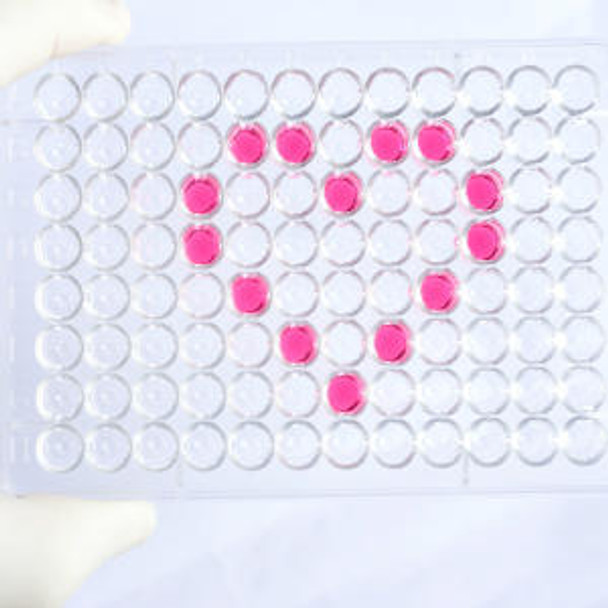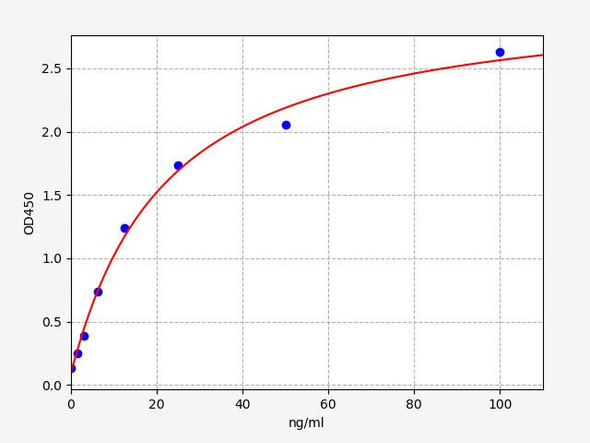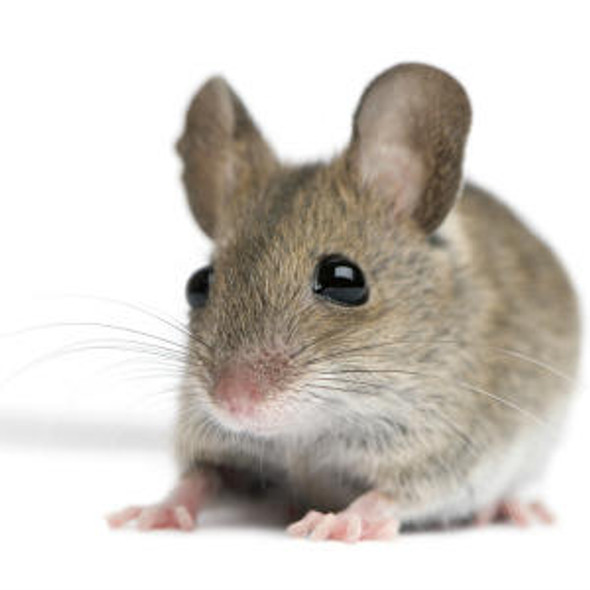Human Pulmonary surfactant-associated protein B (SFTPB) ELISA Kit (HUEB1832)
- SKU:
- HUEB1832
- Product Type:
- ELISA Kit
- Size:
- 96 Assays
- Uniprot:
- P07988
- Range:
- 7.8-500 ng/mL
- ELISA Type:
- Sandwich
- Synonyms:
- SPB, Pulmonary Surfactant Associated Protein B, SFTPB, SP-B, SFTP3, Pulmonary surfactant-associated proteolipid SPL, Phe, 18 kDa pulmonary-surfactant protein, 6 kDa protein
- Reactivity:
- Human
Description
Human Pulmonary surfactant-associated protein B (SFTPB) ELISA Kit
The Human Pulmonary Surfactant-Associated Protein B (SFTPB) ELISA Kit is a reliable tool for accurately detecting levels of SFTPB in human samples such as serum, plasma, and cell culture supernatants. This kit offers high sensitivity and specificity, ensuring precise and reproducible results for a variety of research purposes.SFTPB is a critical component of pulmonary surfactant, which plays a key role in maintaining lung function and preventing alveolar collapse.
Dysregulation of SFTPB has been associated with various respiratory conditions, making it a valuable biomarker for studying lung diseases and potential therapeutic interventions.With its user-friendly design and robust performance, the Human Pulmonary Surfactant-Associated Protein B (SFTPB) ELISA Kit is a valuable asset for researchers interested in exploring the role of SFTPB in pulmonary health and disease.
| Product Name: | Human Pulmonary surfactant-associated protein B (SFTPB) ELISA Kit |
| SKU: | HUEB1832 |
| Size: | 96T |
| Target: | Human Pulmonary surfactant-associated protein B (SFTPB) |
| Synonyms: | 18 kDa pulmonary-surfactant protein, 6 kDa protein, Pulmonary surfactant-associated proteolipid SPL(Phe), SP-B, SFTP3 |
| Assay Type: | Sandwich |
| Detection Method: | ELISA |
| Reactivity: | Human |
| Detection Range: | 7.8-500ng/mL |
| Sensitivity: | 3ng/mL |
| Intra CV: | 5.1% | ||||||||||||||||||||
| Inter CV: | 8.1% | ||||||||||||||||||||
| Linearity: |
| ||||||||||||||||||||
| Recovery: |
| ||||||||||||||||||||
| Function: | Pulmonary surfactant-associated proteins promote alveolar stability by lowering the surface tension at the air-liquid interface in the peripheral air spaces. SP-B increases the collapse pressure of palmitic acid to nearly 70 millinewtons per meter. |
| Uniprot: | P07988 |
| Sample Type: | Serum, plasma, tissue homogenates, cell culture supernates and other biological fluids |
| Specificity: | Natural and recombinant human Pulmonary surfactant-associated protein B |
| Sub Unit: | Homodimer; disulfide-linked. |
| Research Area: | Cardiovascular |
| Subcellular Location: | Secreted Extracellular space Surface film |
| Storage: | Please see kit components below for exact storage details |
| Note: | For research use only |
| UniProt Protein Function: | SFTPB: Pulmonary surfactant-associated proteins promote alveolar stability by lowering the surface tension at the air- liquid interface in the peripheral air spaces. SP-B increases the collapse pressure of palmitic acid to nearly 70 millinewtons per meter. Defects in SFTPB are the cause of pulmonary surfactant metabolism dysfunction type 1 (SMDP1); also called pulmonary alveolar proteinosis due to surfactant protein B deficiency. A rare lung disorder due to impaired surfactant homeostasis. It is characterized by alveolar filling with floccular material that stains positive using the periodic acid- Schiff method and is derived from surfactant phospholipids and protein components. Excessive lipoproteins accumulation in the alveoli results in severe respiratory distress. Genetic variations in SFTPB are a cause of susceptibility to respiratory distress syndrome in premature infants (RDS). RDS is a lung disease affecting usually premature newborn infants. It is characterized by deficient gas exchange, diffuse atelectasis, high-permeability lung edema and fibrin-rich alveolar deposits called 'hyaline membranes'. A variation Ile to Thr at position 131 influences the association between specific alleles of SFTPA1 and respiratory distress syndrome in premature infants. |
| UniProt Protein Details: | Protein type:Secreted, signal peptide; Secreted Chromosomal Location of Human Ortholog: 2p12-p11.2 Cellular Component: extracellular space; lysosome Biological Process: organ morphogenesis; sphingolipid metabolic process; respiratory gaseous exchange Disease: Surfactant Metabolism Dysfunction, Pulmonary, 1 |
| NCBI Summary: | This gene encodes the pulmonary-associated surfactant protein B (SPB), an amphipathic surfactant protein essential for lung function and homeostasis after birth. Pulmonary surfactant is a surface-active lipoprotein complex composed of 90% lipids and 10% proteins which include plasma proteins and apolipoproteins SPA, SPB, SPC and SPD. The surfactant is secreted by the alveolar cells of the lung and maintains the stability of pulmonary tissue by reducing the surface tension of fluids that coat the lung. The SPB enhances the rate of spreading and increases the stability of surfactant monolayers in vitro. Multiple mutations in this gene have been identified, which cause pulmonary surfactant metabolism dysfunction type 1, also called pulmonary alveolar proteinosis due to surfactant protein B deficiency, and are associated with fatal respiratory distress in the neonatal period. Alternatively spliced transcript variants encoding the same protein have been identified.[provided by RefSeq, Feb 2010] |
| UniProt Code: | P07988 |
| NCBI GenInfo Identifier: | 288856299 |
| NCBI Gene ID: | 6439 |
| NCBI Accession: | NP_000533.3 |
| UniProt Secondary Accession: | P07988,Q96R04, |
| UniProt Related Accession: | P07988 |
| Molecular Weight: | 42,117 Da |
| NCBI Full Name: | pulmonary surfactant-associated protein B |
| NCBI Synonym Full Names: | surfactant protein B |
| NCBI Official Symbol: | SFTPB |
| NCBI Official Synonym Symbols: | SP-B; PSP-B; SFTB3; SFTP3; SMDP1 |
| NCBI Protein Information: | pulmonary surfactant-associated protein B; 6 kDa protein; 18 kDa pulmonary-surfactant protein; pulmonary surfactant-associated proteolipid SPL(Phe) |
| UniProt Protein Name: | Pulmonary surfactant-associated protein B |
| UniProt Synonym Protein Names: | 18 kDa pulmonary-surfactant protein; 6 kDa protein; Pulmonary surfactant-associated proteolipid SPL(Phe) |
| Protein Family: | Pulmonary surfactant-associated protein |
| UniProt Gene Name: | SFTPB |
| UniProt Entry Name: | PSPB_HUMAN |
| Component | Quantity (96 Assays) | Storage |
| ELISA Microplate (Dismountable) | 8×12 strips | -20°C |
| Lyophilized Standard | 2 | -20°C |
| Sample Diluent | 20ml | -20°C |
| Assay Diluent A | 10mL | -20°C |
| Assay Diluent B | 10mL | -20°C |
| Detection Reagent A | 120µL | -20°C |
| Detection Reagent B | 120µL | -20°C |
| Wash Buffer | 30mL | 4°C |
| Substrate | 10mL | 4°C |
| Stop Solution | 10mL | 4°C |
| Plate Sealer | 5 | - |
Other materials and equipment required:
- Microplate reader with 450 nm wavelength filter
- Multichannel Pipette, Pipette, microcentrifuge tubes and disposable pipette tips
- Incubator
- Deionized or distilled water
- Absorbent paper
- Buffer resevoir
*Note: The below protocol is a sample protocol. Protocols are specific to each batch/lot. For the correct instructions please follow the protocol included in your kit.
Allow all reagents to reach room temperature (Please do not dissolve the reagents at 37°C directly). All the reagents should be mixed thoroughly by gently swirling before pipetting. Avoid foaming. Keep appropriate numbers of strips for 1 experiment and remove extra strips from microtiter plate. Removed strips should be resealed and stored at -20°C until the kits expiry date. Prepare all reagents, working standards and samples as directed in the previous sections. Please predict the concentration before assaying. If values for these are not within the range of the standard curve, users must determine the optimal sample dilutions for their experiments. We recommend running all samples in duplicate.
| Step | |
| 1. | Add Sample: Add 100µL of Standard, Blank, or Sample per well. The blank well is added with Sample diluent. Solutions are added to the bottom of micro ELISA plate well, avoid inside wall touching and foaming as possible. Mix it gently. Cover the plate with sealer we provided. Incubate for 120 minutes at 37°C. |
| 2. | Remove the liquid from each well, don't wash. Add 100µL of Detection Reagent A working solution to each well. Cover with the Plate sealer. Gently tap the plate to ensure thorough mixing. Incubate for 1 hour at 37°C. Note: if Detection Reagent A appears cloudy warm to room temperature until solution is uniform. |
| 3. | Aspirate each well and wash, repeating the process three times. Wash by filling each well with Wash Buffer (approximately 400µL) (a squirt bottle, multi-channel pipette,manifold dispenser or automated washer are needed). Complete removal of liquid at each step is essential. After the last wash, completely remove remaining Wash Buffer by aspirating or decanting. Invert the plate and pat it against thick clean absorbent paper. |
| 4. | Add 100µL of Detection Reagent B working solution to each well. Cover with the Plate sealer. Incubate for 60 minutes at 37°C. |
| 5. | Repeat the wash process for five times as conducted in step 3. |
| 6. | Add 90µL of Substrate Solution to each well. Cover with a new Plate sealer and incubate for 10-20 minutes at 37°C. Protect the plate from light. The reaction time can be shortened or extended according to the actual color change, but this should not exceed more than 30 minutes. When apparent gradient appears in standard wells, user should terminatethe reaction. |
| 7. | Add 50µL of Stop Solution to each well. If color change does not appear uniform, gently tap the plate to ensure thorough mixing. |
| 8. | Determine the optical density (OD value) of each well at once, using a micro-plate reader set to 450 nm. User should open the micro-plate reader in advance, preheat the instrument, and set the testing parameters. |
| 9. | After experiment, store all reagents according to the specified storage temperature respectively until their expiry. |
When carrying out an ELISA assay it is important to prepare your samples in order to achieve the best possible results. Below we have a list of procedures for the preparation of samples for different sample types.
| Sample Type | Protocol |
| Serum | If using serum separator tubes, allow samples to clot for 30 minutes at room temperature. Centrifuge for 10 minutes at 1,000x g. Collect the serum fraction and assay promptly or aliquot and store the samples at -80°C. Avoid multiple freeze-thaw cycles. If serum separator tubes are not being used, allow samples to clot overnight at 2-8°C. Centrifuge for 10 minutes at 1,000x g. Remove serum and assay promptly or aliquot and store the samples at -80°C. Avoid multiple freeze-thaw cycles. |
| Plasma | Collect plasma using EDTA or heparin as an anticoagulant. Centrifuge samples at 4°C for 15 mins at 1000 × g within 30 mins of collection. Collect the plasma fraction and assay promptly or aliquot and store the samples at -80°C. Avoid multiple freeze-thaw cycles. Note: Over haemolysed samples are not suitable for use with this kit. |
| Urine & Cerebrospinal Fluid | Collect the urine (mid-stream) in a sterile container, centrifuge for 20 mins at 2000-3000 rpm. Remove supernatant and assay immediately. If any precipitation is detected, repeat the centrifugation step. A similar protocol can be used for cerebrospinal fluid. |
| Cell culture supernatant | Collect the cell culture media by pipette, followed by centrifugation at 4°C for 20 mins at 1500 rpm. Collect the clear supernatant and assay immediately. |
| Cell lysates | Solubilize cells in lysis buffer and allow to sit on ice for 30 minutes. Centrifuge tubes at 14,000 x g for 5 minutes to remove insoluble material. Aliquot the supernatant into a new tube and discard the remaining whole cell extract. Quantify total protein concentration using a total protein assay. Assay immediately or aliquot and store at ≤ -20 °C. |
| Tissue homogenates | The preparation of tissue homogenates will vary depending upon tissue type. Rinse tissue with 1X PBS to remove excess blood & homogenize in 20ml of 1X PBS (including protease inhibitors) and store overnight at ≤ -20°C. Two freeze-thaw cycles are required to break the cell membranes. To further disrupt the cell membranes you can sonicate the samples. Centrifuge homogenates for 5 mins at 5000xg. Remove the supernatant and assay immediately or aliquot and store at -20°C or -80°C. |
| Tissue lysates | Rinse tissue with PBS, cut into 1-2 mm pieces, and homogenize with a tissue homogenizer in PBS. Add an equal volume of RIPA buffer containing protease inhibitors and lyse tissues at room temperature for 30 minutes with gentle agitation. Centrifuge to remove debris. Quantify total protein concentration using a total protein assay. Assay immediately or aliquot and store at ≤ -20 °C. |
| Breast Milk | Collect milk samples and centrifuge at 10,000 x g for 60 min at 4°C. Aliquot the supernatant and assay. For long term use, store samples at -80°C. Minimize freeze/thaw cycles. |










